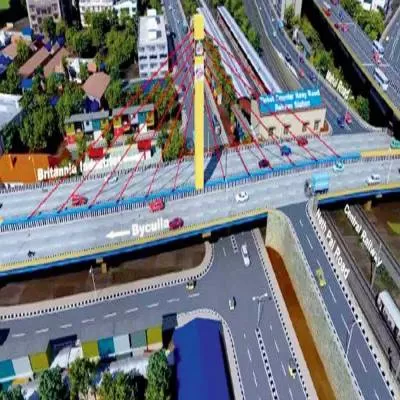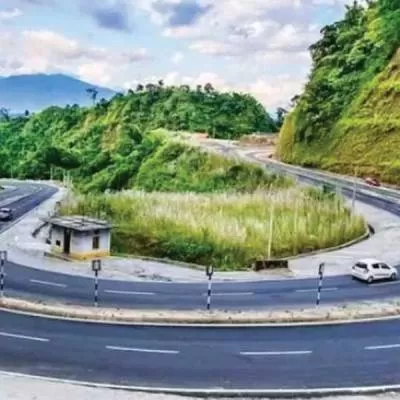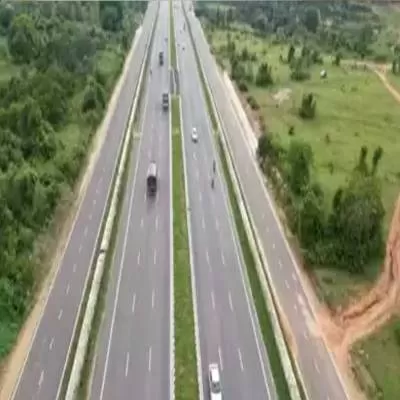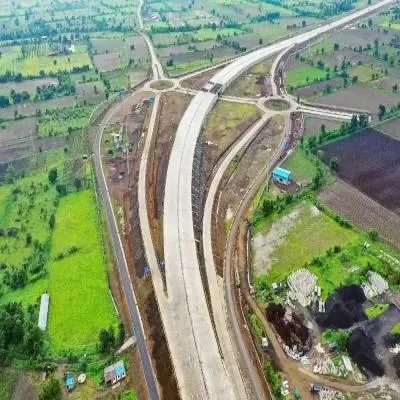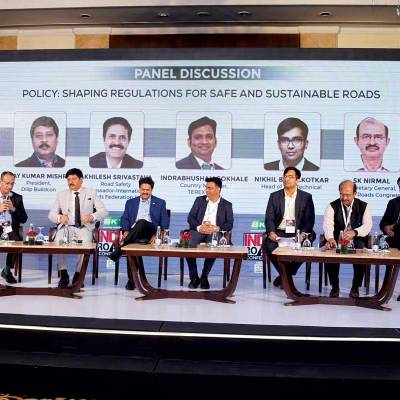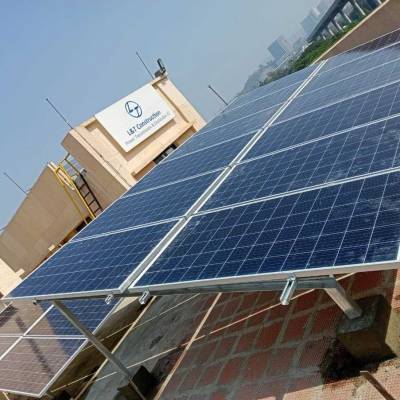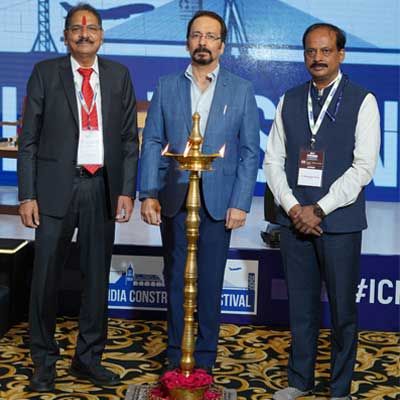- Home
- Infrastructure Transport
- ROADS & HIGHWAYS
- Banking on maturity
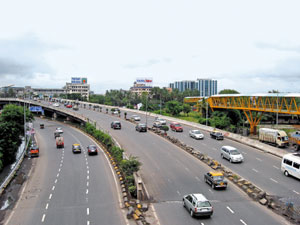
Banking on maturity
The Indian economy faces tricky times. Government plans outline the creation of infrastructure worth $1 trillion over the next five years, because developing new roads, power plants, airports and metros will boost investment rates across the economy and help trigger an economic revival. But, where's the cash for all this construction? Government machineries lack fiscal space. Private-sector sources are expected to cough up $500 billion or half the plan outlay. Only, they are crying out for funds as well.
Finance crunch
Bank finance is becoming increasingly challenging to arrange and comes with stiffer terms and covenants, partly because the overexposure of the banking sector to infrastructure finance has developed negative sentiments about that segment.
Banks close to hitting their sectoral caps in the infrastructure sector are financing only select projects. "Banks are becoming choosier about the projects they give loans for," says Karthikeyan TV, CFO, L&T Infrastructure Development Projects Ltd (L&T IDPL). "They are supporting bankable projects executed by developers with good pedigree and a strong track record."
Careful evaluation
Banks are developing strategies to minimise their risk and develop better portfolio quality. A prudent strategy of HDFC Bank is to prefer to fund contractors as opposed to funding the principal developer of infrastructure. Essentially, the bank sees shorter-term contracting activities as more bankable transactions because contractors get paid out of the project disbursement, which is made secure the moment the project achieves financial closure, much before the commencement of work. So, funding the contractor amounts to supporting a transaction for which the banking system has already pledged support to the principal developer.
Also, banks carefully evaluate the contractor's books prior to sanctioning finance. What do they look for? "Banks evaluate the size and quality of the contractor's order book," explains Dipak Ashar, CFO Consultant. "An ideal order book has an even mix of short-term and long-term jobs. The risk of delay increases if many of the jobs are slated for completion at a later date; this also diminishes the bank's confidence in regular repayment. Banks also want to know if the job that finance is sought for is progressing well and generating regular cash flows. Banks want to see progress at the site. They like projects that get executed fast because this translates into smooth cash flows."
Essentially, banks are becoming increasingly cautious about companies that bite off more than they can chew. "Clients as well as banks find that some companies aim for front-ended cash flows," adds Ashar. "They take on more than they can execute. Then, they try to cope with the huge orderbook by executing a big chunk of one project, raising a heavy bill and diverting those funds to the next job. Progress at the first project's site subsequently slows down for want of attention and resources. Speedy sequential execution of a project is a healthy practice, and it makes sense to invest in technology that can help achieve this. Applications for finance of companies that boast a track record of executing projects fast are more likely to find favour with banks."
Skewed support
Bank credit disbursed in recent years has been heavily concentrated in a handful of companies. According to Credit Suisse, over 20 per cent of the incremental loans given in the last year were to just 10 groups engaged with infrastructure. These include the bigwigs of the industry: Anil Dhirubhai Ambani Group, Lanco Infratech, GMR Group, GVK Group, Jaiprakash Associates, etc. Over the past five years alone, these groups have been loaned $97 billion. Many infrastructure companies have incurred huge debts in the past five years to build assets. But such intense concentration brings risks. The average group debt/ EBITDA is over 7.5, four of the 10 groups having an interest cover of less than one and they are all free cash flow negative.
It is unlikely that the Indian banking system can extend further incremental credit to this lot. But these 10 groups are slated to commission around 70 per cent of the incremental private-sector power capacity under development (through to 2017), and many roads, port and airport projects. How will these companies finance their activities?
Maturing industry
In recent months, markets have been abuzz with talk of leading infrastructure developers exploring options to sell stakes in their projects to raise finance for other ongoing development work. "This is part of the natural maturing process of the industry," says Subbarao Amarthaluru, Group CFO, GMR Group. "An 'asset-light' approach is a prudent financial practice wherein a company divests itself of its non-core assets to churn its portfolio. Leading global infrastructure companies such as the Macquarie Group have been following this model. As the Indian infrastructure development scene matures, companies here will start to practice these accepted models as well. We have also chosen to pursue an asset-light approach to churn a good chunk of our invested capital."
According to Shailesh Pathak, President, Srei Infrastructure Finance Ltd, "Given the downturn, most infrastructure companies are working hard at monetising assets and driving down debt levels. At Srei, we have seen four to five such economic downturns and have huge insight on the dynamics of this industry at the economic downturn and boom phase. We have helped many of our customers by assisting them with an alternate business opportunity as well as advising them on efficient project and account management as a result of which they have successfully come out as winners through the crisis." Timing is everything for asset churn. Karthikeyan clarifies that L&T IDPL believes in monetising its assets only at the right time. "We follow the policy of a calibrated portfolio churn," he says. "We don't get rid of assets just because we need finance for ongoing projects."
Capital infusion
Might capital markets be one new source of funds, new partners that companies considering selling stakes are looking for? Capital markets are known for being risk-averse and wary about dealing with the regulatory apparatus of the Indian Government. They also seek a higher return profile, averaging 20 per cent return on equity, which is practically impossible given the low infrastructure user costs mandated in India. But the shares of many companies are touching rock bottom now.
'Buy low and sell high' is the general thumb rule for good investments and the shares of many companies are now available at very attractive prices, on a price-earning level as well as a price to book approach," agrees Pathak.
He proposes that investors should carefully seek out such value investing opportunities, and start building up positions from now, to make super profits by the next market boom. "judge companies for their inherent strength, their history, management bandwidth, order book and their ability to manage crisis," he urges.
Long-haul finance
Capital markets are apt to take flight given the slightest fluctuation in the economy. So it comes as no surprise that commercial banks have been the financial mainstay of the infrastructure sector thus far. But new government policy is likely to change this situation.
"Commercial banks are financing a lot of infrastructure projects even though it is well established that banks aren't the best source of finance for projects with a long payback period," observes Subbarao. "Institutional long-term finance available at a fixed rate of interest is better suited to infrastructure projects. But such finance made available from bonds, pension funds and insurance simply wasn't available when India started to aggressively develop infrastructure about five to seven years ago. Only recently has the Government created the regulatory frame¡work for Infrastructure Debt Funds (IDFs) to tap into sources of savings like insurance and pension funds to ease the situation."
Srei is one of the country's leading private-sector, non-banking financial institutions in the infrastructure space. Venture capital and private equity aside, the company recently received approval from SEBI to launch an IDF through the mutual fund route. According to Pathak, "Our approach continues to be that of a holistic infrastructure institution, wherein we try to take care of all the financial requirements of our partners. If that means understanding every kind of instrument and channel, so be it. We possess the insight to deliver." New regulations for IDF will gradually accelerate and increase the flow of long-term debt in infrastructure projects. This, in turn, will make infrastructure projects more bankable. And that is saying a lot.
Bankable projects
Recent bidding for railways, irrigation, water supply and sanitation, and port projects has been sluggish. Coupled with the mine to line issues plaguing power projects, and sluggishness in the highway and airport segments, this saw infrastructure investments plunge 46 per cent in the last fiscal, as per the Reserve Bank of India's annual report. Surely this lack of interest cannot be attributed in whole to the credit crunch? "Project finance depends on how well the project is structured," says Dhruba Purkayastha, President & CEO, Financial Advisory Division, Feedback Infra. "Properly structured projects are reaching financial closure in spite of banks being overexposed to the infrastructure sectors. If project bonds are used to refinance infrastructure projects and infrastructure debt funds prove to be of help, the situation may improve."
Clearly, there is a pressing need to put the focus back on the basics. Government bodies must ask themselves if other reasons such as environmental clearance delays and land acquisition hurdles are causing developers to shy away from projects. If the Government were to table projects that are ready to go, the interest of developers would increase because this feature in itself lends itself to financial closure.
A country serious about infrastructure development might also see more initiatives like the Asian Development Bank's (ADB) September 2012 launch of an experimental $128 million facility to infuse funds into Indian infrastructure. ADB has tied up with India Infrastructure Finance Co (IIFCL) to partially guarantee rupee-denominated bonds issued to refinance bank loans.
It hopes to attract investments from pension funds and insurers, and support up to five infrastructure project bonds over the next three years.
GMR Group will be the first beneficiary of this facility. It plans to refinance debt incurred from building and operating part of a toll expressway. "This credit enhancement product, designed by IIFCL, enables infra developers to achieve higher credit rating, thus enabling them to offer corporate bonds with acceptable credit rating for investors," says Subbarao. "Otherwise, given the business model of infra projects, infra developers generally have credit ratings below A category, whereas investors in corporate bonds like insurance companies, pension funds and mutual funds look for higher credit rating (AA and above)."
What the country badly needs is enough of such new initiatives to go around.
Quick Bytes
• Banks prefer financing projects that get executed fast as this translates into smooth cash flows.
• Leading infrastructure developers are exploring options to sell stakes to raise finance. "The new government policy is likely to reduce the dependence of capital markets on commercial banks.
Expert finance tips
Prasad Devatha, Head-Finance, Essar Project Business Group, explains how to use non-funded finance schemes to curtail the utilisation of cash limits, cut down on interest payments, and improve cash flows:
• Use cash credit limits judiciously: At present, interest on cash credit is a very high, i.e. 13-14 per cent. Instead, open a letter of credit (LC) against the vendor by using the banks' non-funded based limits. LC opening charges are 1 per cent per annum and bill discounting charges for 180 days are 9.50 per cent per annum. This will reduce the cost of borrowing by 3-4 per cent.
• Avail clean bill discounting: If your client is accepted for clean bill discounting, interest cost goes to client account. This saves around 12 per cent interest.
• Manage foreign procurements: Open a LC on the foreign vendor for goods and services procured from overseas by taking either supplier credits/buyer's credit. At present, buyer's credit for six months costs LIBOR + 150 basis points - it is available for 360 days for opex purchases and for three years for items of a capital nature. Doing so will cost you 3 per cent against 13 per cent payable on a cash credit account subject to natural hedging. If natural hedging is not available, hedging cost is 5 per cent per annum.
• Deal efficiently with subcontractors: Ask your client for a transferable LC on your subcontractor with your company named as the first beneficiary. Obtaining this can help avoid the complexity and cost of double financing.
• Centralise cash management operations: Today, projects sites are spread across the country. Centralising cash management services through e-payment gateway options can minimise interest cost by keeping funds in cash credit account instead of funds lying in current account at various sites. Banks like ICICI Bank, HDFC Bank and IDBI offer this facility to make payments directly to the vendor and avoid operational glitches.
• Deploy NTREES: Essar Projects is the first EPC Company in India to have forged an alliance with SIDBI and the NSE to create an electronic supermarket for discounting SME vendor bills. NTREES is a centralised electronic platform for the safe and secure electronic remittance of funds to small vendors. It is specially designed to simplify the traditional processes of submitting invoice, bill of exchange and supporting documents. It reduces manpower cost and paperwork. NTREES is a multiple banking approach that ushers in paperless operations, reduces transaction costs and the exposure on purchasing companies.
• Deploy e-workflow, a portal to automate work: By implementing the e-workflow automation tool, sites can request LCs or bank guarantee through this portal. Documents needn't be sent from sites to HO through courier. The portal ensures end-to-end process visibility, speedy approvals using outlook, automated filing/printing on respective bank templates along with approved scanned signatures. It consolidates MIS information at all levels, including senior-level management.
Lessons to learn
Raising funds against the security of promoters' equity: Dipak Ashar, CFO Consultant, says this can be a good practice, provided it is not overdone. Such funds can be used to repay loans and release shares. If a judicious limit is crossed, however, it could result in promoters having to sell their stake, which in turn can put pressure on the share price and reduce the promoters' holding in the business. So, carefully consider the impact of such borrowing.
From the downswing in finance sufficiency: Karthikeyan TV, CFO, L&T Infrastructure Development Projects Ltd, believes, "Tighter financial markets will usher in greater financial discipline. Companies will make more realistic bids. Five years' experience of developing infrastructure in the PPP model is an adequate base to build on, for every long-term infrastructure developer. As the appetite of financial investors for greenfield risks is currently low, we need to find a different class of partners that would be willing to settle for lower returns post project implementation, when the execution risk falls and cash flows are stable."
Bank credit is fast running out. Instruments and financiers to support the next wave of infrastructure development are works in progress. While infrastructure finance appears to be transiting towards maturity, Charu Bahri wonders if it is happening quickly enough. The Indian economy faces tricky times. Government plans outline the creation of infrastructure worth $1 trillion over the next five years, because developing new roads, power plants, airports and metros will boost investment rates across the economy and help trigger an economic revival. But, where's the cash for all this construction? Government machineries lack fiscal space. Private-sector sources are expected to cough up $500 billion or half the plan outlay. Only, they are crying out for funds as well. Finance crunch Bank finance is becoming increasingly challenging to arrange and comes with stiffer terms and covenants, partly because the overexposure of the banking sector to infrastructure finance has developed negative sentiments about that segment. Banks close to hitting their sectoral caps in the infrastructure sector are financing only select projects. "Banks are becoming choosier about the projects they give loans for," says Karthikeyan TV, CFO, L&T Infrastructure Development Projects Ltd (L&T IDPL). "They are supporting bankable projects executed by developers with good pedigree and a strong track record." Careful evaluation Banks are developing strategies to minimise their risk and develop better portfolio quality. A prudent strategy of HDFC Bank is to prefer to fund contractors as opposed to funding the principal developer of infrastructure. Essentially, the bank sees shorter-term contracting activities as more bankable transactions because contractors get paid out of the project disbursement, which is made secure the moment the project achieves financial closure, much before the commencement of work. So, funding the contractor amounts to supporting a transaction for which the banking system has already pledged support to the principal developer. Also, banks carefully evaluate the contractor's books prior to sanctioning finance. What do they look for? "Banks evaluate the size and quality of the contractor's order book," explains Dipak Ashar, CFO Consultant. "An ideal order book has an even mix of short-term and long-term jobs. The risk of delay increases if many of the jobs are slated for completion at a later date; this also diminishes the bank's confidence in regular repayment. Banks also want to know if the job that finance is sought for is progressing well and generating regular cash flows. Banks want to see progress at the site. They like projects that get executed fast because this translates into smooth cash flows." Essentially, banks are becoming increasingly cautious about companies that bite off more than they can chew. "Clients as well as banks find that some companies aim for front-ended cash flows," adds Ashar. "They take on more than they can execute. Then, they try to cope with the huge orderbook by executing a big chunk of one project, raising a heavy bill and diverting those funds to the next job. Progress at the first project's site subsequently slows down for want of attention and resources. Speedy sequential execution of a project is a healthy practice, and it makes sense to invest in technology that can help achieve this. Applications for finance of companies that boast a track record of executing projects fast are more likely to find favour with banks." Skewed support Bank credit disbursed in recent years has been heavily concentrated in a handful of companies. According to Credit Suisse, over 20 per cent of the incremental loans given in the last year were to just 10 groups engaged with infrastructure. These include the bigwigs of the industry: Anil Dhirubhai Ambani Group, Lanco Infratech, GMR Group, GVK Group, Jaiprakash Associates, etc. Over the past five years alone, these groups have been loaned $97 billion. Many infrastructure companies have incurred huge debts in the past five years to build assets. But such intense concentration brings risks. The average group debt/ EBITDA is over 7.5, four of the 10 groups having an interest cover of less than one and they are all free cash flow negative. It is unlikely that the Indian banking system can extend further incremental credit to this lot. But these 10 groups are slated to commission around 70 per cent of the incremental private-sector power capacity under development (through to 2017), and many roads, port and airport projects. How will these companies finance their activities? Maturing industry In recent months, markets have been abuzz with talk of leading infrastructure developers exploring options to sell stakes in their projects to raise finance for other ongoing development work. "This is part of the natural maturing process of the industry," says Subbarao Amarthaluru, Group CFO, GMR Group. "An 'asset-light' approach is a prudent financial practice wherein a company divests itself of its non-core assets to churn its portfolio. Leading global infrastructure companies such as the Macquarie Group have been following this model. As the Indian infrastructure development scene matures, companies here will start to practice these accepted models as well. We have also chosen to pursue an asset-light approach to churn a good chunk of our invested capital." According to Shailesh Pathak, President, Srei Infrastructure Finance Ltd, "Given the downturn, most infrastructure companies are working hard at monetising assets and driving down debt levels. At Srei, we have seen four to five such economic downturns and have huge insight on the dynamics of this industry at the economic downturn and boom phase. We have helped many of our customers by assisting them with an alternate business opportunity as well as advising them on efficient project and account management as a result of which they have successfully come out as winners through the crisis." Timing is everything for asset churn. Karthikeyan clarifies that L&T IDPL believes in monetising its assets only at the right time. "We follow the policy of a calibrated portfolio churn," he says. "We don't get rid of assets just because we need finance for ongoing projects." Capital infusion Might capital markets be one new source of funds, new partners that companies considering selling stakes are looking for? Capital markets are known for being risk-averse and wary about dealing with the regulatory apparatus of the Indian Government. They also seek a higher return profile, averaging 20 per cent return on equity, which is practically impossible given the low infrastructure user costs mandated in India. But the shares of many companies are touching rock bottom now. 'Buy low and sell high' is the general thumb rule for good investments and the shares of many companies are now available at very attractive prices, on a price-earning level as well as a price to book approach," agrees Pathak. He proposes that investors should carefully seek out such value investing opportunities, and start building up positions from now, to make super profits by the next market boom. "judge companies for their inherent strength, their history, management bandwidth, order book and their ability to manage crisis," he urges. Long-haul finance Capital markets are apt to take flight given the slightest fluctuation in the economy. So it comes as no surprise that commercial banks have been the financial mainstay of the infrastructure sector thus far. But new government policy is likely to change this situation. "Commercial banks are financing a lot of infrastructure projects even though it is well established that banks aren't the best source of finance for projects with a long payback period," observes Subbarao. "Institutional long-term finance available at a fixed rate of interest is better suited to infrastructure projects. But such finance made available from bonds, pension funds and insurance simply wasn't available when India started to aggressively develop infrastructure about five to seven years ago. Only recently has the Government created the regulatory frame¡work for Infrastructure Debt Funds (IDFs) to tap into sources of savings like insurance and pension funds to ease the situation." Srei is one of the country's leading private-sector, non-banking financial institutions in the infrastructure space. Venture capital and private equity aside, the company recently received approval from SEBI to launch an IDF through the mutual fund route. According to Pathak, "Our approach continues to be that of a holistic infrastructure institution, wherein we try to take care of all the financial requirements of our partners. If that means understanding every kind of instrument and channel, so be it. We possess the insight to deliver." New regulations for IDF will gradually accelerate and increase the flow of long-term debt in infrastructure projects. This, in turn, will make infrastructure projects more bankable. And that is saying a lot. Bankable projects Recent bidding for railways, irrigation, water supply and sanitation, and port projects has been sluggish. Coupled with the mine to line issues plaguing power projects, and sluggishness in the highway and airport segments, this saw infrastructure investments plunge 46 per cent in the last fiscal, as per the Reserve Bank of India's annual report. Surely this lack of interest cannot be attributed in whole to the credit crunch? "Project finance depends on how well the project is structured," says Dhruba Purkayastha, President & CEO, Financial Advisory Division, Feedback Infra. "Properly structured projects are reaching financial closure in spite of banks being overexposed to the infrastructure sectors. If project bonds are used to refinance infrastructure projects and infrastructure debt funds prove to be of help, the situation may improve." Clearly, there is a pressing need to put the focus back on the basics. Government bodies must ask themselves if other reasons such as environmental clearance delays and land acquisition hurdles are causing developers to shy away from projects. If the Government were to table projects that are ready to go, the interest of developers would increase because this feature in itself lends itself to financial closure. A country serious about infrastructure development might also see more initiatives like the Asian Development Bank's (ADB) September 2012 launch of an experimental $128 million facility to infuse funds into Indian infrastructure. ADB has tied up with India Infrastructure Finance Co (IIFCL) to partially guarantee rupee-denominated bonds issued to refinance bank loans. It hopes to attract investments from pension funds and insurers, and support up to five infrastructure project bonds over the next three years. GMR Group will be the first beneficiary of this facility. It plans to refinance debt incurred from building and operating part of a toll expressway. "This credit enhancement product, designed by IIFCL, enables infra developers to achieve higher credit rating, thus enabling them to offer corporate bonds with acceptable credit rating for investors," says Subbarao. "Otherwise, given the business model of infra projects, infra developers generally have credit ratings below A category, whereas investors in corporate bonds like insurance companies, pension funds and mutual funds look for higher credit rating (AA and above)." What the country badly needs is enough of such new initiatives to go around. Quick Bytes • Banks prefer financing projects that get executed fast as this translates into smooth cash flows. • Leading infrastructure developers are exploring options to sell stakes to raise finance. "The new government policy is likely to reduce the dependence of capital markets on commercial banks. Expert finance tips Prasad Devatha, Head-Finance, Essar Project Business Group, explains how to use non-funded finance schemes to curtail the utilisation of cash limits, cut down on interest payments, and improve cash flows: • Use cash credit limits judiciously: At present, interest on cash credit is a very high, i.e. 13-14 per cent. Instead, open a letter of credit (LC) against the vendor by using the banks' non-funded based limits. LC opening charges are 1 per cent per annum and bill discounting charges for 180 days are 9.50 per cent per annum. This will reduce the cost of borrowing by 3-4 per cent. • Avail clean bill discounting: If your client is accepted for clean bill discounting, interest cost goes to client account. This saves around 12 per cent interest. • Manage foreign procurements: Open a LC on the foreign vendor for goods and services procured from overseas by taking either supplier credits/buyer's credit. At present, buyer's credit for six months costs LIBOR + 150 basis points - it is available for 360 days for opex purchases and for three years for items of a capital nature. Doing so will cost you 3 per cent against 13 per cent payable on a cash credit account subject to natural hedging. If natural hedging is not available, hedging cost is 5 per cent per annum. • Deal efficiently with subcontractors: Ask your client for a transferable LC on your subcontractor with your company named as the first beneficiary. Obtaining this can help avoid the complexity and cost of double financing. • Centralise cash management operations: Today, projects sites are spread across the country. Centralising cash management services through e-payment gateway options can minimise interest cost by keeping funds in cash credit account instead of funds lying in current account at various sites. Banks like ICICI Bank, HDFC Bank and IDBI offer this facility to make payments directly to the vendor and avoid operational glitches. • Deploy NTREES: Essar Projects is the first EPC Company in India to have forged an alliance with SIDBI and the NSE to create an electronic supermarket for discounting SME vendor bills. NTREES is a centralised electronic platform for the safe and secure electronic remittance of funds to small vendors. It is specially designed to simplify the traditional processes of submitting invoice, bill of exchange and supporting documents. It reduces manpower cost and paperwork. NTREES is a multiple banking approach that ushers in paperless operations, reduces transaction costs and the exposure on purchasing companies. • Deploy e-workflow, a portal to automate work: By implementing the e-workflow automation tool, sites can request LCs or bank guarantee through this portal. Documents needn't be sent from sites to HO through courier. The portal ensures end-to-end process visibility, speedy approvals using outlook, automated filing/printing on respective bank templates along with approved scanned signatures. It consolidates MIS information at all levels, including senior-level management. Lessons to learn Raising funds against the security of promoters' equity: Dipak Ashar, CFO Consultant, says this can be a good practice, provided it is not overdone. Such funds can be used to repay loans and release shares. If a judicious limit is crossed, however, it could result in promoters having to sell their stake, which in turn can put pressure on the share price and reduce the promoters' holding in the business. So, carefully consider the impact of such borrowing. From the downswing in finance sufficiency: Karthikeyan TV, CFO, L&T Infrastructure Development Projects Ltd, believes, "Tighter financial markets will usher in greater financial discipline. Companies will make more realistic bids. Five years' experience of developing infrastructure in the PPP model is an adequate base to build on, for every long-term infrastructure developer. As the appetite of financial investors for greenfield risks is currently low, we need to find a different class of partners that would be willing to settle for lower returns post project implementation, when the execution risk falls and cash flows are stable."


